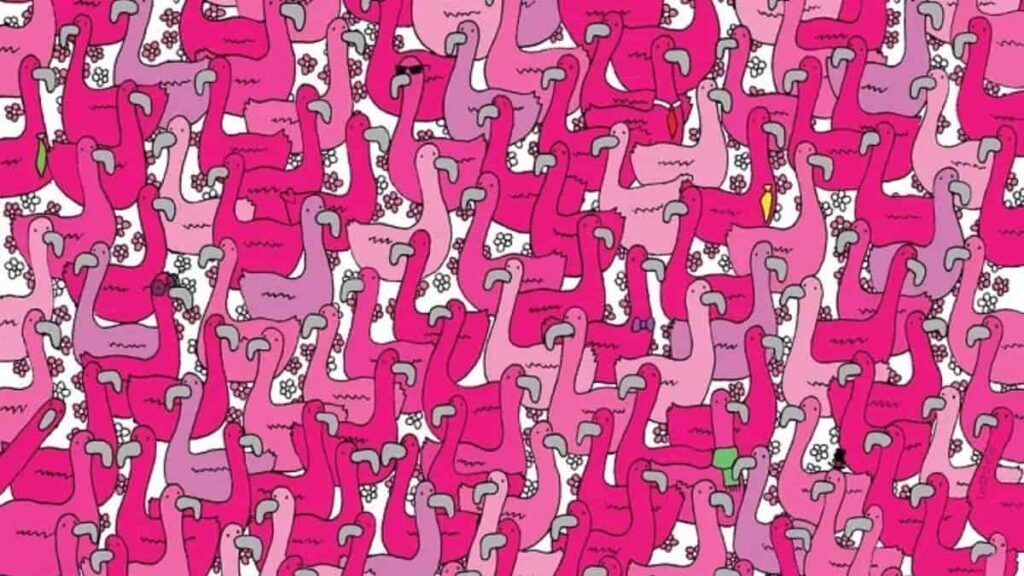In the realm of visual perception, optical illusions have long captivated and confounded human minds.
These phenomena play tricks on our brains, challenging our perception of reality and revealing the intricate workings of our visual processing systems.
Among the myriad of illusions that have intrigued researchers and enthusiasts alike, one particular challenge has gained attention: the quest to spot hidden hearts in a matter of seconds.
Proclaiming that only geniuses can unravel these concealed symbols, this optical illusion serves as a fascinating exploration into the complexities of human cognition.
Understanding Optical Illusions:

Before delving into the specifics of the hidden heart challenge, it’s essential to grasp the fundamentals of optical illusions.
These phenomena occur when our brains misinterpret visual information, often resulting in perceptions that deviate from objective reality.
Optical illusions exploit various principles of perception, such as contrast, color, depth, and motion, to create misleading images that defy logical interpretation.
One of the most intriguing aspects of optical illusions is their ability to highlight the limitations and biases inherent in human perception.
Despite our reliance on vision as a primary sense, our brains are susceptible to errors and inconsistencies when processing visual stimuli.
Optical illusions provide valuable insights into the mechanisms underlying perception, shedding light on the intricate interplay between sensory input and cognitive processing.
The Hidden Heart Challenge:
Among the countless optical illusions circulating on the internet, the hidden heart challenge has garnered widespread attention for its purported difficulty.
The premise is deceptively simple: participants are presented with an image containing a pattern of geometric shapes and are tasked with locating a concealed heart within a limited timeframe, typically 17 seconds.
Proponents of the challenge claim that only individuals with exceptional cognitive abilities can successfully identify the hidden heart within the allotted time, attributing the task’s difficulty to the brain’s tendency to overlook subtle details.
The allure of the hidden heart challenge lies in its ability to engage participants’ curiosity and competitive spirit.
Whether undertaken as a leisurely diversion or a test of intellectual prowess, the challenge invites individuals to put their perceptual skills to the test and vie for the title of “genius” by swiftly uncovering the elusive symbol hidden amidst the visual clutter.
Psychological Insights:
From a psychological standpoint, the hidden heart challenge offers valuable insights into the mechanisms of visual perception and attention.
The human brain is remarkably adept at filtering and prioritizing information, enabling us to navigate the sensory overload of our environment.
However, this efficiency comes at a cost, as our brains often rely on heuristics and shortcuts that can lead to errors in judgment.
In the context of the hidden heart challenge, participants may fall prey to various cognitive biases and perceptual limitations that impede their ability to detect the concealed symbol.
One such phenomenon is inattentional blindness, wherein individuals fail to notice unexpected objects or events in their field of view due to the brain’s selective allocation of attention.
Additionally, confirmation bias may influence participants to focus their attention on familiar shapes or patterns, leading them to overlook the subtle contours of the hidden heart.
Furthermore, the time constraint imposed by the challenge exacerbates the pressure on participants’ cognitive resources, potentially impairing their ability to process visual information effectively.
As the seconds tick away, individuals may experience heightened stress and cognitive overload, further diminishing their chances of success.
The Role of Expertise:
While proponents of the hidden heart challenge often tout it as a measure of innate intelligence or perceptual acuity, the reality is more nuanced.
Research suggests that expertise and familiarity play significant roles in determining an individual’s performance on visual tasks.
For instance, individuals with training or experience in pattern recognition may possess a distinct advantage when confronted with the challenge, as their brains are better equipped to discern meaningful patterns amidst noise and distraction.
Moreover, factors such as cultural background, cognitive style, and individual differences in visual processing can influence one’s ability to perceive and interpret the hidden heart.
What may appear as a trivial task to some may pose a considerable challenge to others, highlighting the subjectivity inherent in assessments of perceptual ability.
Practical Applications:
Beyond its entertainment value, the hidden heart challenge has implications for various fields, including psychology, neuroscience, and education.
By studying participants’ responses to the task, researchers can gain insights into the neural mechanisms underlying visual perception and attention.
This knowledge may inform the development of interventions aimed at improving perceptual skills or mitigating the impact of cognitive biases on decision-making.
In educational settings, visual puzzles and challenges like the hidden heart can serve as valuable tools for assessing and enhancing students’ cognitive abilities.
Incorporating such activities into curriculum design can foster critical thinking skills, spatial reasoning, and attentional control, ultimately empowering learners to navigate the complexities of the visual world with greater proficiency.
Conclusion:
The hidden heart challenge stands as a testament to the enduring fascination with optical illusions and the mysteries of human perception.
Whether viewed as a whimsical diversion or a window into the inner workings of the mind, this enigmatic puzzle continues to captivate and intrigue individuals of all ages and backgrounds.
As participants endeavor to unravel the secrets of the hidden heart, they embark on a journey of discovery that transcends the confines of mere visual perception.
In confronting the challenge, they confront the intricacies of their own cognitive processes, grappling with the complexities of attention, memory, and decision-making.
Ultimately, the hidden heart challenge serves as a reminder of the boundless potential of the human mind and the endless wonders that await exploration in the realm of perception and cognition.
Whether one emerges victorious or falls short in the quest to spot the concealed symbol, the journey itself is a testament to the enduring allure of optical illusions and the enduring quest for understanding in the ever-evolving landscape of human consciousness.

